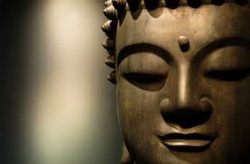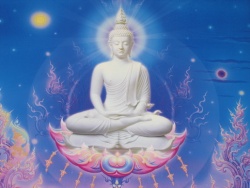Difference between revisions of "Sikhī Buddha"
(Created page with "thumb|250px| <poem> According to the Buddhavamsa and Buddhist mythology, Sikhī (Pāli) is the twenty-third of twenty-eight Buddhas. The penultimate B...") |
|||
| (3 intermediate revisions by 2 users not shown) | |||
| Line 1: | Line 1: | ||
[[File:Ima5421ges.jpg|thumb|250px|]] | [[File:Ima5421ges.jpg|thumb|250px|]] | ||
| + | |||
| + | |||
| + | |||
| + | |||
| + | [[Shikhin]] ({{BigTibetan|[[གཙུག་གཏོར་ཅན་]]}}, ''[[gtsug gtor can]]'') | ||
| + | |||
<poem> | <poem> | ||
| − | According to the Buddhavamsa and Buddhist mythology, Sikhī (Pāli) is the twenty-third of twenty-eight Buddhas. The penultimate Buddha of the Alamkarakalpa (Adorned Eon), Sikhī was preceded by Vipassī Buddha and succeeded by Vessabhū Buddha. | + | According to the [[Buddhavamsa]] and [[Buddhist]] [[mythology]], [[Sikhī]] ([[Pāli]]) is the twenty-third of [[twenty-eight Buddhas]]. |
| + | |||
| + | The penultimate [[Buddha]] of the [[Alamkarakalpa]] ([[Adorned Eon]]), [[Sikhī]] was preceded by [[Vipassī Buddha]] and succeeded by [[Vessabhū Buddha]]. | ||
| + | |||
| + | {{Wiki|Etymology}} | ||
| − | + | He was called [[Sikhī]] because his [[unhisa]] (turban) looked like a [[sikha]] (flame). | |
| + | {{Wiki|Biography}} | ||
| − | + | According to the [[Buddhavamsa]] as well as [[traditional]] [[Buddhist]] legend, [[Sikhī]] lived 31 [[kalpas]] — many millions of years — before the {{Wiki|present}} [[time]]. | |
| − | |||
| − | + | He was born in [[Aruṇavatī]], which is located in the Dhule district of {{Wiki|Maharashtra}}, in present-day [[India]]. | |
| + | |||
| + | His [[family]] was of the [[Kshatriya]] [[varna]], which constituted the ruling and {{Wiki|military}} {{Wiki|elite}} of the {{Wiki|Vedic}} period. | ||
| + | |||
| + | His father was [[Aruṇa]] the warrior-chief, and his mother was [[Pabhāvatī]]. | ||
| + | |||
| + | His wife was [[Sabbakama]], and he had a son named [[Atula]]. | ||
[[File:BUDDMoon.jpg|thumb|250px|]] | [[File:BUDDMoon.jpg|thumb|250px|]] | ||
| − | Sikhī lived in the palaces of Sucanda, Giri and Vāhana for 7,000 years until he renounced his worldly life, riding out of the palace on an elephant. He practiced asceticism for eight months before attaining enlightenment under a pundarika tree. | + | [[Sikhī]] lived in the {{Wiki|palaces}} of [[Sucanda]], [[Giri]] and [[Vāhana]] for 7,000 years until he renounced his [[worldly]] [[life]], riding out of the palace on an [[elephant]]. |
| + | |||
| + | He practiced [[asceticism]] for eight months before [[attaining]] [[enlightenment]] under a [[pundarika tree]]. | ||
| − | + | Just prior to achieving [[buddhahood]], he accepted a [[bowl]] of milk {{Wiki|rice}} from the daughter of [[Piyadassī]] (a [[sethi]] from the town of [[Sudassana Nigama]]), and sat on a grass seat prepared by [[Anomadassi]], an [[Ājīvika]] [[ascetic]]. | |
| − | |||
| − | Sikhī was 37 cubits tall, which is roughly equal to 56 feet (17 m). His body radiated light for a distance of three leagues, which is roughly equal to 9 miles (14 km). | + | Sources differ as to how long [[Sikhī]] lived. He was reported to have [[died]] in [[Dussarama]] (or [[Assarama]]), somewhere near the Silavati [[River]], at the age of either 37,000 or 70,000 years. |
| + | [[Physical]] [[characteristics]] | ||
| + | |||
| + | [[Sikhī]] was 37 {{Wiki|cubits}} tall, which is roughly {{Wiki|equal}} to 56 feet (17 m). His [[body]] radiated [[light]] for a distance of three leagues, which is roughly {{Wiki|equal}} to 9 {{Wiki|miles}} (14 km). | ||
Teachings | Teachings | ||
| − | Sikhī preached his first sermon in Migachira Park to 100,000 disciples, his second sermon to 80,000 disciples, and his third sermon to 70,000 disciples. | + | [[Sikhī]] [[preached]] his first {{Wiki|sermon}} in Migachira Park to 100,000 [[disciples]], his second {{Wiki|sermon}} to 80,000 [[disciples]], and his third {{Wiki|sermon}} to 70,000 [[disciples]]. |
| − | He demonstrated his twin miracle at a place near Suriyavati under a champaka tree. Abhibhu and Sambhava were his chief monk disciples; and Akhila (or Makhila) and Paduma were his principal female disciples. His chief attendant was Khemankara. Sirivaddha and Chanda (or Nanda) were his chief male patrons; and Chitta and Sugutta were the chief among the women. | + | |
| + | He demonstrated his twin [[miracle]] at a place near Suriyavati under a [[champaka]] [[tree]]. | ||
| + | |||
| + | [[Abhibhu]] and [[Sambhava]] were his chief [[monk]] [[disciples]]; and [[Akhila]] (or [[Makhila]]) and [[Paduma]] were his [[principal]] {{Wiki|female}} [[disciples]]. | ||
| + | |||
| + | His chief attendant was [[Khemankara]]. [[Sirivaddha]] and [[Chanda]] (or [[Nanda]]) were his chief {{Wiki|male}} patrons; and [[Chitta]] and [[Sugutta]] were the chief among the women. | ||
</poem> | </poem> | ||
{{W}} | {{W}} | ||
[[Category:Buddhist Terms]] | [[Category:Buddhist Terms]] | ||
[[Category:Shikhin]] | [[Category:Shikhin]] | ||
Latest revision as of 05:14, 26 March 2016
Shikhin (གཙུག་གཏོར་ཅན་, gtsug gtor can)
According to the Buddhavamsa and Buddhist mythology, Sikhī (Pāli) is the twenty-third of twenty-eight Buddhas.
The penultimate Buddha of the Alamkarakalpa (Adorned Eon), Sikhī was preceded by Vipassī Buddha and succeeded by Vessabhū Buddha.
Etymology
He was called Sikhī because his unhisa (turban) looked like a sikha (flame).
Biography
According to the Buddhavamsa as well as traditional Buddhist legend, Sikhī lived 31 kalpas — many millions of years — before the present time.
He was born in Aruṇavatī, which is located in the Dhule district of Maharashtra, in present-day India.
His family was of the Kshatriya varna, which constituted the ruling and military elite of the Vedic period.
His father was Aruṇa the warrior-chief, and his mother was Pabhāvatī.
His wife was Sabbakama, and he had a son named Atula.
Sikhī lived in the palaces of Sucanda, Giri and Vāhana for 7,000 years until he renounced his worldly life, riding out of the palace on an elephant.
He practiced asceticism for eight months before attaining enlightenment under a pundarika tree.
Just prior to achieving buddhahood, he accepted a bowl of milk rice from the daughter of Piyadassī (a sethi from the town of Sudassana Nigama), and sat on a grass seat prepared by Anomadassi, an Ājīvika ascetic.
Sources differ as to how long Sikhī lived. He was reported to have died in Dussarama (or Assarama), somewhere near the Silavati River, at the age of either 37,000 or 70,000 years.
Physical characteristics
Sikhī was 37 cubits tall, which is roughly equal to 56 feet (17 m). His body radiated light for a distance of three leagues, which is roughly equal to 9 miles (14 km).
Teachings
Sikhī preached his first sermon in Migachira Park to 100,000 disciples, his second sermon to 80,000 disciples, and his third sermon to 70,000 disciples.
He demonstrated his twin miracle at a place near Suriyavati under a champaka tree.
Abhibhu and Sambhava were his chief monk disciples; and Akhila (or Makhila) and Paduma were his principal female disciples.
His chief attendant was Khemankara. Sirivaddha and Chanda (or Nanda) were his chief male patrons; and Chitta and Sugutta were the chief among the women.

